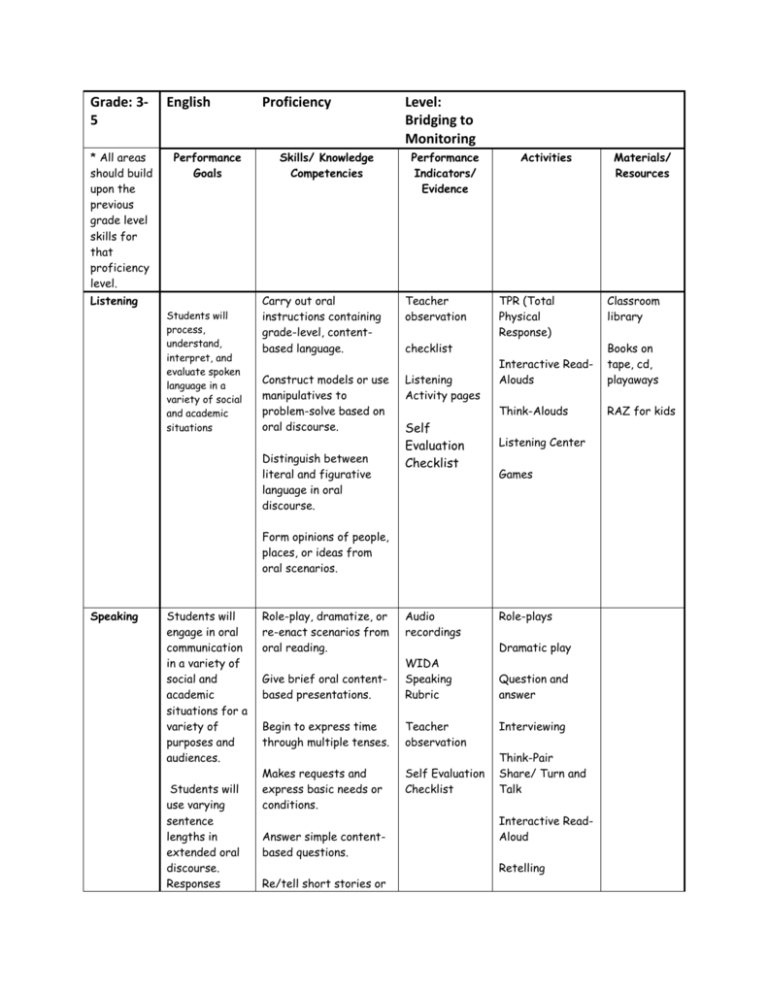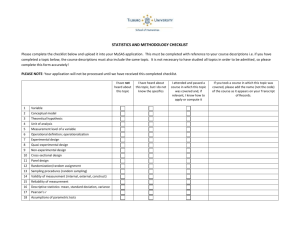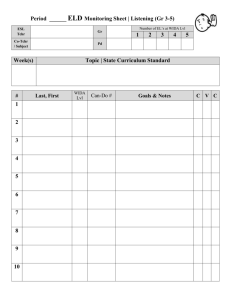Bridging - Monitoring
advertisement

Grade: 35 * All areas should build upon the previous grade level skills for that proficiency level. English Performance Goals Listening Students will process, understand, interpret, and evaluate spoken language in a variety of social and academic situations Proficiency Skills/ Knowledge Competencies Level: Bridging to Monitoring Performance Indicators/ Evidence Carry out oral instructions containing grade-level, contentbased language. Teacher observation Construct models or use manipulatives to problem-solve based on oral discourse. Listening Activity pages Distinguish between literal and figurative language in oral discourse. checklist Self Evaluation Checklist Activities TPR (Total Physical Response) Students will engage in oral communication in a variety of social and academic situations for a variety of purposes and audiences. Students will use varying sentence lengths in extended oral discourse. Responses Role-play, dramatize, or re-enact scenarios from oral reading. Audio recordings Give brief oral contentbased presentations. WIDA Speaking Rubric Begin to express time through multiple tenses. Teacher observation Makes requests and express basic needs or conditions. Answer simple contentbased questions. Re/tell short stories or Self Evaluation Checklist Classroom library Interactive ReadAlouds Books on tape, cd, playaways Think-Alouds RAZ for kids Listening Center Games Form opinions of people, places, or ideas from oral scenarios. Speaking Materials/ Resources Role-plays Dramatic play Question and answer Interviewing Think-Pair Share/ Turn and Talk Interactive ReadAloud Retelling show cohesion and organization to support main idea. events. Make predictions or hypotheses from discourse. Offers creative solutions to issues/problems. Describe pictures, events, objects, or people using phrases or short sentences. Discuss stories, issues, and concepts. Use comparative/contrastive language in contentbased discussions. Express answers to fact and opinion questions, using supporting details Reading Students will process, interpret, and evaluate written language, symbols, and text with understanding and fluency. Identify main ideas and some details. Teacher observation Interactive readaloud Identify story elements (character, setting, problem, solution, and genre.) Benchmark Reading Assessments Guided reading Use context clues and illustrations to determine meaning of word/phrases. Graphic Organizers (Venn Diagram, story maps etc.) Differentiate between fact and opinion in narrative and expository text. Make inferences, predictions, summarizations, and conclusions about written text. Self Evaluation Checklist Partner reading Independent Reading Games Guided Reading books (Rigby ELL A-Z) Sightword readers Grammar: Classifying Words Card Library (Lakeshore) Mentor Text (predicting, inference, summarizing etc.) Reading A-Z readers Writing Students will engage in written communication in a variety of forms for a variety of purposes and audiences. Students will use a variety of sentence lengths with evidence of cohesion and organization. Produce personal narrative, research, and persuasive writing samples. Create compound sentences. (ex. conjunctions) Use transition words in writing multiple paragraphs. Describe events, people, processes, procedures. Summarize content based information. Writing portfolio/ journals Writing skill checklist WIDA Writing rubric Story writing: “Small Moments” White boards Graphic organizers and sentence frames Dry erase markers Independent Writing Erasers Pencil grips Pencils Graphic organizers Self Evaluation Checklist Mentor texts Writing Process Student Folderssets of 10 (Lakeshore)


![Assumptions Checklist [Word File]](http://s3.studylib.net/store/data/005860099_1-a66c5f4eb05ac40681dda51762a69619-300x300.png)




